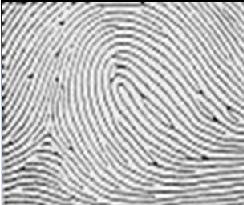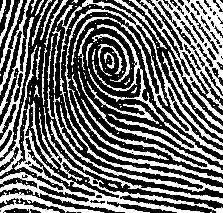
“I do swear by the Day of Resurrection. I do swear by the reproachful soul. Does man assume that We can never assemble his bones? Yes indeed, we are able to put together in perfect order the very tips of his fingers” – (Quran 75: 1-4)
A fingerprint is an impression of the friction ridges on all parts of the finger. A friction ridge is a raised portion of the epidermis on the palmar (palm) or digits (fingers and toes) or plantar (sole) skin, consisting of one or more connected ridge units of friction ridge skin. These are sometimes known as “epidermal ridges” which are caused by the underlying interface between the dermal papillae of the dermis and the interpapillary (rete) pegs of the epidermis. These epidermal ridges serve to amplify vibrations triggered when fingertips brush across an uneven surface, better transmitting the signals to sensory nerves involved in fine texture perception. The ridges assist in gripping rough surfaces, as well as smooth wet surfaces.
Fingerprints may be deposited in natural secretions from the eccrine glands present in friction ridge skin (secretions consisting primarily of water) or they may be made by ink or other contaminants transferred from the peaks of friction skin ridges to a relatively smooth surface such as a fingerprint card.The term fingerprint normally refers to impressions transferred from the pad on the last joint of fingers and thumbs, though fingerprint cards also typically record portions of lower joint areas of the fingers (which are also used to make identifications).
The patterns
Fingerprints of a suspected or an arrested person are taken by the Police. This is to facilitate identification of the person, or use it to trace the involvement of the person in the crime. Fingerprints are the most conclusive means of personal identification of humans. The purpose behind the systematic storage is to enable easy and quick retrieval of the subject’s fingerprints. Sir Francis Galton was instrumental in identifying the patterns and their significance. It was Sir Edward Richard Henry, who made the distinction between the nine different patterns and described them. Fundamentally fingerprints are in four groups. They are:
Arches.
• Plain Arch [A]
• Tented Arch [T]
Loops.
• Radial Loop [R]
• Ulnar Loop [U]
Whorls [W]
(a) Spiral; (b) Concentric.
Composites.
• Twinned Loop [TL or S]
• Central Pocket Loop [CP ]
• Lateral Pocket Loop [LP or S]
• Accidental [X]
ARCHES: Arches are fingerprint patterns in which the ridges traverse form on side to the other, without recurving. They are further sub-classified as Plain and Tented Arch.
![Plain Arch [A] Plain Arch [A]](https://tholath.files.wordpress.com/2009/10/plain-arch-a2.jpg?w=450)
Plain Arch [A]
Plain Arch: This type of arch has ridges flowing smoothly from one side of the pattern to the other, with a slight uprising in the middle region. There are no other features in this type of pattern. They are denoted by the Alphabet [A].They are denoted by the Alphabet [A].
![Tented Arch [T] Tented Arch [T]](https://tholath.files.wordpress.com/2009/10/tented-arch-t3.jpg?w=450)
Tented Arch [T]
Tented Arch: the ridges in this pattern flow from one side of the finger to the other with a sharp uprising in the middle. The core or the mid region of the pattern contains a pole like ridge, which is similar to the pole of a tent. Hence, they are known as Tented Arch. They are denoted by the Alphabet [T].
LOOPS: Loops are patterns where at least one ridge flows from one side of the finger to another, to traverse and recurve to the side of its origin. It is shaped like a hairpin. Loops have one delta only. There are two types of loops. They are Radial and Ulanr Loops.
Radial Loop [R]: the ridges originate from the side of the side of the radial bone of the forearm and exit in the same side.
Ulnar loop [U]: the ridges originate from the side of the little finger and exits in the same side.
In order to distinguish between Ulnar and radial loops you must:
1) Know from which hand the loop pattern comes from and;
2) place your hand palm side down over top of the impression and determine if the recurving ridges originate from the little finger side or the thumb side.
If the ridges flow in from the little finger side this would be an ‘Ulnar’ loop. If the ridges flow in from the thumb side this would be a ‘radial’ loop.


Loop Patterns
WHORLS: whorls are patterns where the ridges recurve several times to form either a spiral, or concentric circles around the central part of the pattern, called the core. They have two deltas (the delta point is a pattern of a fingerprint that resembles the Greek letter delta. It’s the point on a friction ridge at or nearest to the point of divergence of two type lines) on either side. The whorl pattern consists of one or more free recurving ridges and two points of delta. When the line of the fingerprint disc is placed on the two points of delta, it will bisect at least one of the ridges belonging to the core group. They are all designated by the alphabet [W].

Whorl

COMPOSITES: These patterns are a combination of two of the above patterns. They have two deltas.

Central Pocket Loop

Lateral Pocket Loop

Twinned Loop

Accidental
Twinned Loop (T.L / S):
In this type, one loop is found intertwined with another. The point of origin and exit of one loop are different from that of the other. Two deltas can be seen in this pattern.
Double loop:
In this pattern, two loops originate and end at the same point. Here too there are two deltas.
Central Pocket (C.P.):
In Central pocket loops, the majority of the ridges take the form of a loop, but one or more ridges recurve at the core to form a pocket. Two deltas are present in this pattern.
Lateral pocket (L.P.):
When the ridges constituting the loop bend sharply downwards on one side before re-curving, thereby forming on that side an inter-space or ‘pocket’, usually filled by the ridges of another loop, the impression is termed as a lateral pocket loop. The core is placed laterally and there are two deltas.
Accidental (X):
If the impression is too irregular to be classified in any of the above categories, it is known as Accidental. Here there may be more than two deltas.
References:
- http://en.wikipedia.org/wiki/Fingerprint
- http://www.webopedia.com/TERM/D/delta_point.html
- FORENSIC SCIENCE PRACTICAL MANUAL- PROF.ARVIND G.B
- Forensic Science Tutorials – S.B.R.R.MAHAJANA FIRST GRADE COLLEGE

